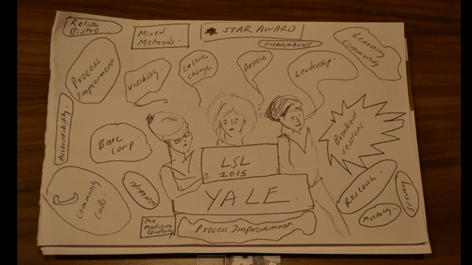Building Perspective-Taking Across Diverse Teams and Organizations
In our paper “Building Perspective-Taking as an Organizational Capability: A Change Intervention in a Health Care Setting” in the Journal of Management Inquiry, we the authors (Thomas Calvard, Emily Cherlin, Amanda Brewster and Leslie Curry) sought to investigate how a two-year change intervention in 10 U.S. hospitals could facilitate perspective-taking among diverse staff.

Thomas Calvard, left, Emily Cherlin, Amanda Brewster, and Leslie Curry
Perspective-taking refers to actively imagining and trying to understand the viewpoints of others by putting ourselves in their shoes and seeing things as they see them. Perspective-taking, along with related but distinct concepts like sympathy and empathy, has a relatively established tradition in psychology of supporting positive relationships and (mostly) cooperative interpersonal outcomes. However, most evidence to date comes from brief laboratory experiments or surveys given to employees asking them about their individual orientations to other workplace parties (e.g. customers, suppliers, leaders).
In a more in-depth qualitative field study in a healthcare setting, we set out to ask – how might perspective-taking be developed as a multidimensional cooperative process and problem-solving capability more widely across teams and organizational systems? Drawing on the existing literature on perspective-taking, we built on conceptions of its interpersonal dimensions, extending and combining them with the idea that organizational systems need cooperative interactions, dialogues and forums for exploring diverse but related roles, identities, and functional backgrounds.
Health care and hospital settings are highly appropriate for studying perspective-taking, given their complex systems of diverse leaders, specialized groups, and agencies, whose views and priorities can vary in their alignment. Our field study involved participant evaluations of the delivery of a two-year change program across 10 U.S. hospitals (2014-2016) called “Leadership Saves Lives” (LSL).
The LSL program emphasized positive culture change, shared leadership and process improvement, and involved each hospital establishing a guiding coalition with 15–20 key staff involved in the care of heart patients with acute myocardial infarction, or AMI. Coalition members included staff with diverse perspectives from multiple departments, professions, and levels of seniority.

The change program comprised a series of egalitarian, inclusive interventions with networks of coalition members focused on role clarity, shared accountability, and creative problem-solving. Interventions included on-site workshops with experiential learning, all-hospital annual forums, and web-based platforms for knowledge sharing and continuous remote support.
Over the two years of the LSL intervention, six of the 10 hospitals involved experienced significantly reduced AMI mortality rates and staff widely reported positive culture change across their organizations. Our study investigated perspective-taking processes based on 393 in-depth interviews with 197 clinical and management staff across three time points—baseline (n = 162), six months (n = 118), and 18 months (n = 113).
We found that, over time, perspective-taking developed across two main levels of abstraction or scope – the local interpersonal level between those working closely together on a coalition or at the same hospital, and the system level, concerning multiple perspectives making up entire organizations and agencies across the integrated health care system. Perspective-taking also developed across three main inter-related dimensions of focus – the affective (emotional experiences of others), the cognitive (task and knowledge contexts of others), and the motivational (willingness to share with and listen to wider perspectives).
Taken together, our two levels crossed with three dimensions of perspective-taking show how, with the right interventions and experiences, organizations can broaden out and build up mutually reinforcing, positive exchanges of views among diverse individuals and groups of staff. While perspective-taking is complex and can be readily threatened by conflicts, pressures, and politics, our findings suggest it is relatively low-risk and low-cost for organizations to try to encourage perspective-taking by seeking to bring together diverse change coalitions frequently and supportively for empathic engagements and problem-solving across their organizational ecosystems.



























































































